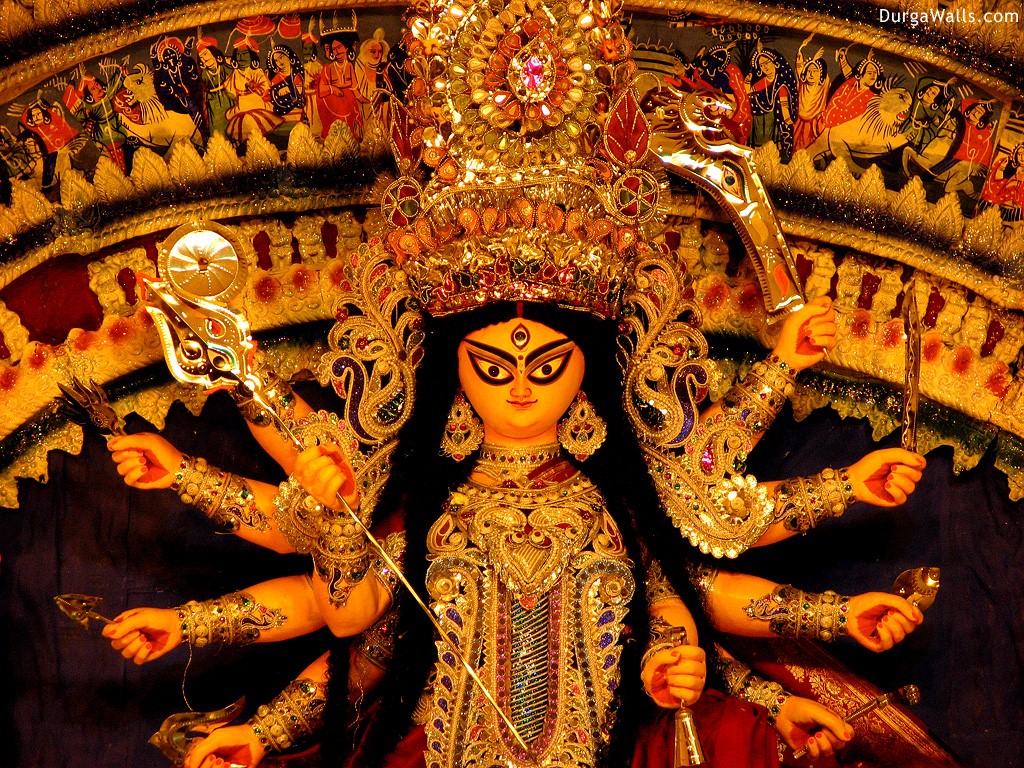Goddess Durga
In Hindu mythology it is believed that time (kala) started when Lord Brahma who is the creator of the world, got divided into two forms – male and female. The female represents life and male represents the shield and spear. The male energy divided himself into three forms namely Lord Brahma who is known as the creator, Lord Vishnu who is known as the caretaker and Lord Shiva known as the demolisher. Later, the female energy (nature) divided into three forms to endorse Shakti (energy) – namely Goddess Lakshmi who is goddess of wealth, Goddess Durga known as the energy herself and Goddess Saraswati known as goddess of education (Vidya). All these three Shakthi’s (energies) had each three avatars of them and all those avatars (descent) together came to be known as Nav Durga (nine Shaktis). Dussera festival is associated with worshiping of the Shaktis.There are several legends associated with this festival. In the Epic of Ramayan, Lord Rama had killed Ravana – the king of Lanka for abducting his wife Sita. Before fighting the war with Ravana, Lord Rama worshipped Goddess Durga for nine days and seeked her blessings and got back his wife Sita. Obviously, he won the war. In this epic Rama depicts virtues and Ravana depicts ego. Dussera marks the victory of Lord Rama over Ten-Headed demon Ravana; the good winning over the evil.
Another legend is associated to mark the victory of Goddess Durga who defeated Demon Mahishasura. There was a time when demons became powerful and they started wars with the Gods to capture heaven. Goddess Durga came to their rescue. She took up the form of Shakti to kill Demon Mahishasura. She rode on a lion, to fight with Mahishasura for nine days and nights. On the tenth day, she killed Demon Mahishasura. Good wins over the evil.
In the Mahabharatha epic, Dussera which also called Vijaya Dashami marks the end of “Agyatvas” or exile of Pandvas in disguise. They were to spend twelve years in exile and the thirteenth year in disguise. The Pandavas were defeated in the game of dice by their cousins Kauravas. On the day of Dussera, the Pandavas completed their thirteen years of exile and came about to claim their rightful kingdom.
Burning of statue of Ravana – the ten faced demon
So, this festival has in fact spiritual meaning; it is all about burning the ego. On Dussera, statue of Ravana is burnt to depict burning of ego, lust, attachment and desire for bringing peace and harmony in life. After burning the evil inside, one can easily tramp on the path of spirituality dedicatedly. In nutshell, this festival is sign of true happiness; we all have a Ravana (demon) inside us.
In most of northern India and some parts of Maharashtra, Dussera or Dush-Hara is celebrated in honour of Lord Rama to commemorate the victory of Lord Rama over Ravana. In West Bengal and the east of India, Durga Puja takes centre stage of Dussera festivities. They celebrate the victory of goddess Durga over the demon Mahishasura.
The festival is called Bathukamma in Andhra/Telengana and is celebrated during the same time, and has many myths associated with it, one of them being victory of Durga over Mahishasura. Many people in India follow rituals for the nine days. In Tamilnadu, Karnataka, and Andhra, we the festival is called as Golu. Guajarati people celebrate it with dance called Garba. The word garba comes from the Sanskrit word for womb and so implies gestation of life. Traditionally, the dance is performed around a clay lantern with a light inside, called a Garbha Deep (womb lamp). The lantern represents life and the foetus in the womb in particular. The dancers thus honour Durga, the feminine form of divinity. The Buddists celebrate Ashok Vijaya Dashmi to honor Emperor Ashoka because he converted to Budhism on Dussera.
In the nutshell, Dussera is celebrated as victory of good over evil. People also do Aayudha (weapons) Puja for worshipping of tools. The day is auspicious to start any new venture, also, for Vidyarambha— starting educational endeavour for small kids. It marks beginning of new things. During the nine days, seeds are planted in earthen pots and the saplings are offered to Goddess Durga.
It is important to preserve our cultural heritage, because it keeps us united. Though the cultural heritage is indefinable and intangible, the cultural essence is passed on from one generation to the next and it’s important and necessary to let it continue that way.














































